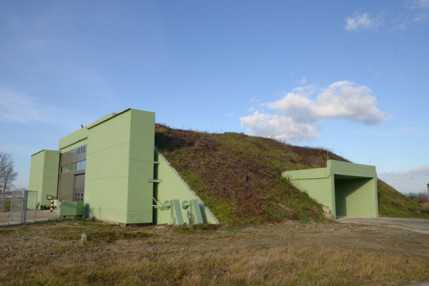New Transient Hazardous Material Storage Facility Completed at Pápa Air Base
Szöveg: sacprogram.org | 2016. január 1. 11:15Member nations of the Strategic Airlift Capability (SAC) are investing in the infrastructure at Pápa Air Base in order to enhance the ability of the base to serve as an air transportation hub. Completion of the new Transient Hazardous Material (HAZMAT) Storage Facility enables SAC to respond to a broader spectrum of its member nations’ airlift needs and will be operational from January 1, 2016.

(Photo: HAW / OF-1 Tuomas Saavalainen)
The new facility was constructed by completely refurbishing a Cold War-era hardened aircraft shelter. The reinforced concrete walls and the thick soil roof cover of the old shelter make sure that the structure of the facility is solid. In addition, creating a safe working environment has been of paramount importance in the design of the new compound. The old aircraft shelter has been refurbished with gas sensors, a fire detection system, a spill-resistant floor, an emergency shower unit and a spark-free electric supply and lighting system.
Construction of the HAZMAT storage facility is part of the SAC Infrastructure Development Project, managed by the NATO Airlift Management Programme Office (NAM PO) of NATO Support and Procurement Agency (NSPA). The next important milestone in infrastructure development at Pápa Air Base will be the completion of the SAC Hangar Complex in 2016. According to the project timeline, the new offices will be ready in May 2016 and the new hangar in October 2016.
The new HAZMAT facility enables the operational unit of the SAC, the Heavy Airlift Wing (HAW), to handle goods designated as HAZMAT in accordance with international, EU and Hungarian regulations. Major Pieter de Bock (Royal Netherlands Air Force), Air Movement Officer at the HAW, emphasizes that the new facility enhances the capability of the SAC to serve its member nations’ airlift needs with transient HAZMAT storage capacity. Thanks to the new storage facilities, Pápa Air Base increases its function as a hub when SAC member nations request transportation of HAZMAT to and from mission areas.

About the Strategic Airlift Capability
The Strategic Airlift Capability (SAC), established in 2008, is an independent and multinational program that provides access to military airlift capability to its 12 partner nations by owning and operating three Boeing C-17 Globemaster III long-range cargo jets.
SAC is based at the Hungarian Defence Forces (HDF) Pápa Air Base, Hungary.
The SAC Nations are the NATO members Hungary (program host nation), Bulgaria, Estonia, Lithuania, the Netherlands, Norway, Poland, Romania, Slovenia and the United States and NATO Partnership for Peace nations Finland and Sweden. Each participating nation owns a share of the available flight hours of the SAC C-17s to serve the needs of their national defense, NATO, EU or UN commitments and humanitarian relief efforts.
SAC organizations consist of the operational arm, the Heavy Airlift Wing (HAW) and the NATO Airlift Management (NAM) Programme Office that is the acquisition and sustainment authority of the SAC C-17 weapon system. It also provides site and administrational support to the HAW.
The Boeing Company is contracted by SAC to provide technical support for the C-17 aircraft.